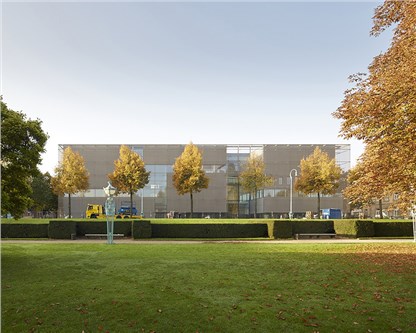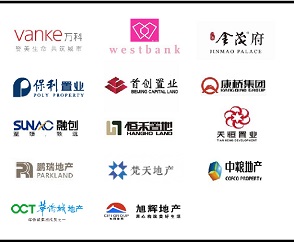GMP: 德国曼海姆美术馆新馆设计/New Kunsthalle Mannheim
▲曼海姆美术馆新馆 New Kunsthalle Mannheim
曼海姆美术馆新馆经过两年半建设将在2017年12月18日正式交付使用。由gmp·冯·格康,玛格及合伙人建筑师事务所执笔设计的曼海姆美术馆新馆是目前德国规模最大的博物馆建筑,新建建筑以引人瞩目的姿态被置入周边环境中。gmp建筑师事务所此前在海外建成了包括北京中国国家博物馆、河内城市博物馆在内的多座展览建筑,曼海姆美术馆新馆是gmp在德国建成的第一座相等体量的博物馆建筑。
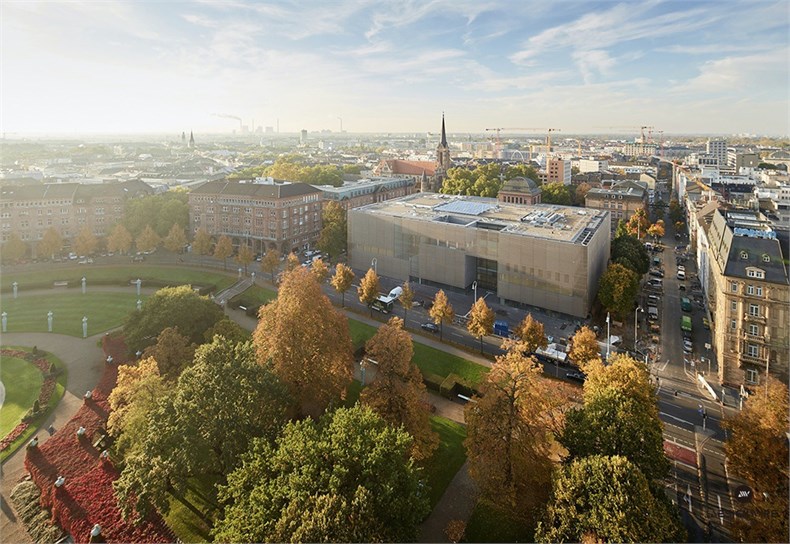
▲鸟瞰图 aerial view
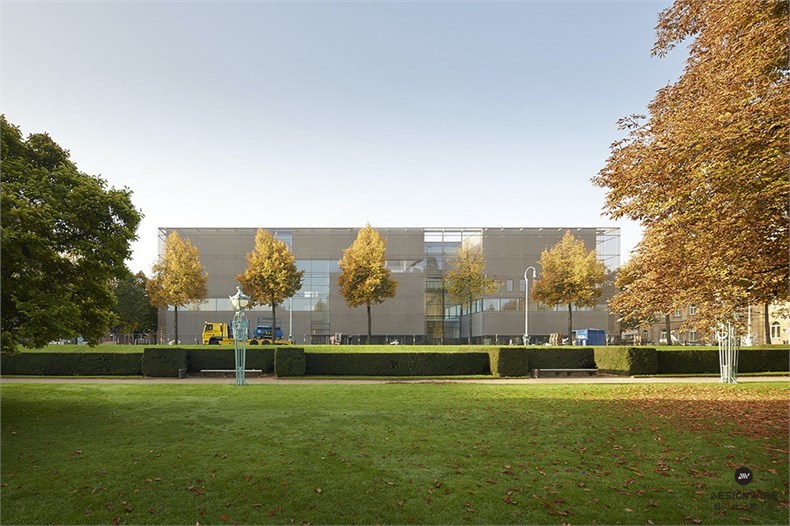
▲建筑正面 front view
After a construction period of about two-and-a-half years, the new building of Kunsthalle Mannheim will be handed over to the city and its citizens on 18 December 2017. The design by the architects von Gerkan, Marg and Partners (gmp) is for one of the currently largest museum buildings in Germany which, with its unmistakable appearance, confidently stands amongst the neighboring buildings. After several large museum projects in Asia, such as the Maritime Museum in Lingang New City (China), the National Museum in Beijing, and the Hanoi Museum (Vietnam), this is gmp’s first new museum building of comparable dimensions in Germany.
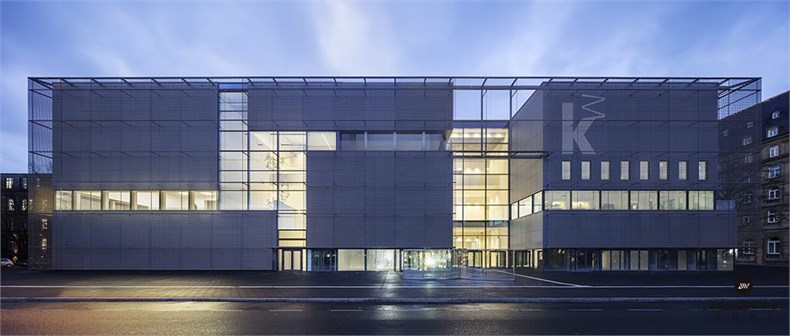
▲建筑正面 front view
美术馆新建部分位于曼海姆菲德烈广场之上,与由赫尔曼·彼凌设计的青年风格旧馆历史建筑局部相连,建筑从一个“城中之城”的理念发展而来。在一个简洁的整体体块内,独立的展览和附属功能空间穿插错落,构成极富张力的空间尺度。单体空间围合于一个中央光庭四周,其间的交通通过连廊、平台和空中桥梁实现。这令人们联想到城市中构成空间的元素——建筑和街区,道路和广场;充满变化的交通流线、闭合与开放的转换,为建筑室内增添了丰富多变的视角。如此一来,美术馆正如同曼海姆棋盘状的城市布局一般,一个整体上严谨有序的结构提供了清晰有效的空间辨识性,同时丰富多样的建造形态、变换退进的空间边界、挑空留白和叠加扩展塑造出崭新的空间体验,令其独一无二。
The new museum building at Friedrichsplatz in Mannheim links up with the existing Art Nouveau building, the so-called “Billing” building, and has been designed as a “city in the city.” Within a simple overall structure, individual cubes have been arranged in an inspiring composition to provide exhibition space and rooms for supporting functions. They enclose a central atrium and are linked via galleries, terraces, and bridges. In analogy to the elements that make up urban environments—buildings, blocks, streets, and squares—varied circular routes are created for the visitors through closed and open spaces with changing vistas and outlooks. Nevertheless, visitors find it easy to get their bearings in the museum, which replicates the straightforward, ordered structure of the “city of squares” that is Mannheim. At the same time, every situation along the route of the exhibitions offers new impressions—just as in cities no place is like another owing to the diversity of the architecture, changes in the building lines, and recesses, squares, and open spaces.

▲建筑幕墙 facade
在城市布局上,正如同100年前美术馆建立时的初衷,位于菲德烈广场公园一侧坐落着美术馆气势磅礴的主立面。来访者将从位于这里的主入口进入中央光庭。贯通三个层面之上的永久展览和各种临时展览的参观流线起始于此,三层中的两层直接与旧馆相连。大尺度展览空间拥有照明屋顶,可以营造变化的光线效果; 独立的立方体展览空间内设有侧光照明;另外一座大型观景平台可以陈设美术馆极具价值的雕塑收藏。美术馆第三层参观流线内设有一座屋顶花园,在这里可以将菲德烈广场包括著名的水塔景致尽收眼底。
As had already been envisaged at the time of the foundation of the Kunsthalle a hundred years ago, it is given a prestigious elevation towards the park at Friedrichsplatz. From there, visitors enter the central atrium via the new main entrance. The atrium is the point of orientation and also the starting point for the circular tours through the exhibition areas on three levels, two of which are connected with the Art Nouveau building via the historic Athene tract and from there with the open-air sculptures garden. The exhibition concept consists of large spaces with light ceilings, which can be used in various different ways, and two cubes with side lighting. On the third floor a roof terrace has been integrated in the circular tour, from where visitors can enjoy the panoramic view of Friedrichsplatz with the distinctive water tower. This space concept results in the museum and city spaces being functionally and visually interwoven, ensuring that the art radiates out into the city through the architecture and also that the city flows virtually without barriers into the rooms of the new buildings.
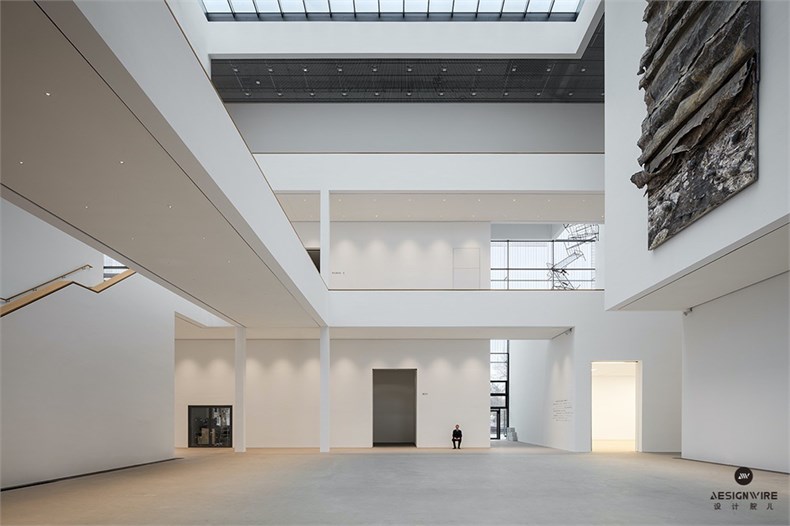
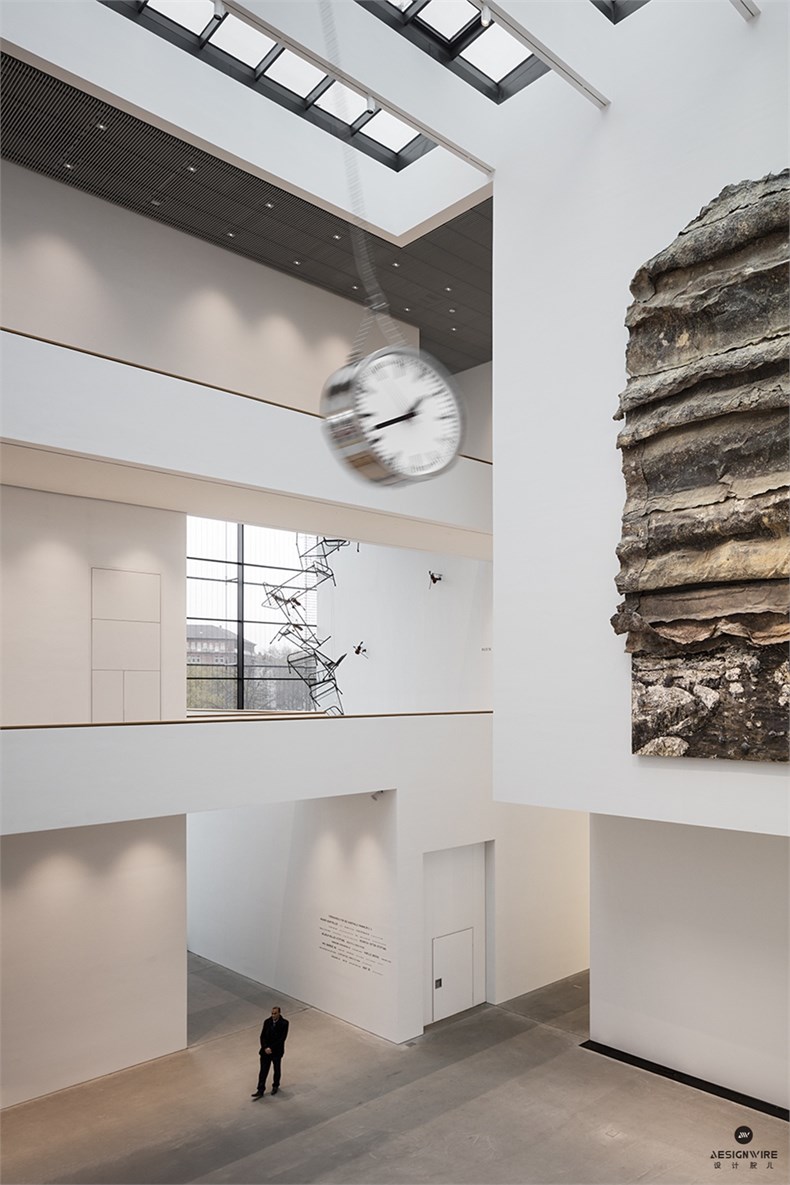
▲中庭 atrium
美术馆的立面由透明的黄铜色不锈钢织网覆盖,定义出建筑整体色彩基调,尊重了周边建筑多采用的当地特有砂岩质地。织网网孔大小的变化实现了外立面不同的透明度需要。这样的设计令建筑体的整体性得到了很好的强调,而建筑内独立的展览空间体块则会在白天和夜晚照明效果改变时刻、或者远近视角变换过程中逐渐显露自身。“艺术之城”的理念体现在一个统一的城市肌理之下,每一座独立建筑体都可以实现自我表达,这样的展览空间可以最大程度地实现艺术展览在策划和布置上的自由度。
The facades are cloaked with a transparent metal mesh with bronze-colored coating that defines the external shape of the building and creates a respectful dialogue with the sandstone color of the neighboring buildings.Varying degrees of transparency are achieved with different mesh widths. Thus, the integrity of the overall building shape is preserved so that the individual volumes can be seen in their graded differences from close up or further away, by day and by night. Just as the urban structure of a city provides the ordering context in which each individual building expresses itself, the “city of art” concept creates an architectural framework which gives rise to an identity and, at the same time, provides maximum flexibility for the curator.
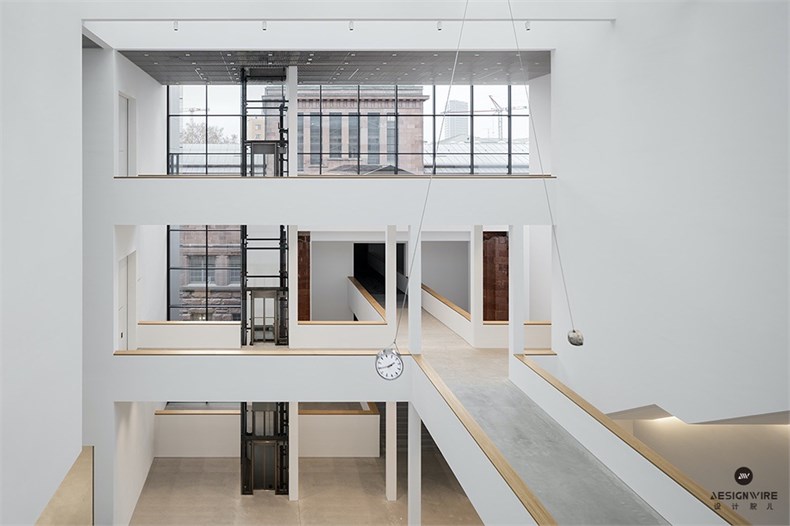
▲二层过道 corridor cross the second floor
建筑立面上黄铜不锈钢织网赋予了博物馆建筑体块令人过目难忘的整体形象。金属织网由位于北莱茵·威斯特法伦城市迪伦的织造工场专门依据曼海姆美术馆的需求设计生产,具有艺术创造上的独一性。 整个金属织网覆面由72组独立的镀铜不锈钢面板构成, 总面积4635平方米。每8条直径3毫米的不锈钢管由四股缠绕的绞索固定。织网表皮悬挂于固定在封闭幕墙外直径25毫米的钢管上。 织网表面镀铜钢管密度排布的不同呈现出程度各异的通透感,实现了与室外不同的视线联系,也在不同的季节、不同日光照射条件下呈现出生动而富于变幻的形象。在夜晚,自重44吨,高21米的立面可以通过103组聚光灯照亮。通过精确的设计安装,金属织网外表皮可在极端温度或飓风等特殊气候条件下保持原状。
The architectural character of the new building is largely deter- mined by the stainless steel mesh, which makes up the exterior shape of the new museum and creates its unmistakable appear- ance. The metal mesh construction was specifically developed and produced for the Mannheim project by GKD technical weav- ing mill, Düren, and therefore is the only example of its kind. The mesh consists of a total of 72 individual bronze-colored stainless steel panels, together spanning an area of 4,635 square meters. Every lot of eight wire elements of stainless steel with a 3 millimeter diameter is connected by a warp wire consisting of four interwoven parts. In the areas where the mesh has been fit- ted in front of windowless facades, 25 millimeter diameter tubes are then fitted as the next layer. Through this differentiation, fields with different transparencies are created which, depending on the viewing angle, allow differ- ent views in and out of the building, and result in a vibrant, changeable external appearance in the course of changes in day- light and season. During the hours of darkness, this special, 21 meter high external envelope, which weighs 44 tonnes, can be illuminated with 103 spotlights. The mesh had to be designed and built with extreme precision in order to ensure that, with the help of pre-tensioning, it retains its dimensions and its pre-de- fined shape also when exposed to extreme temperatures or strong gusts of wind.
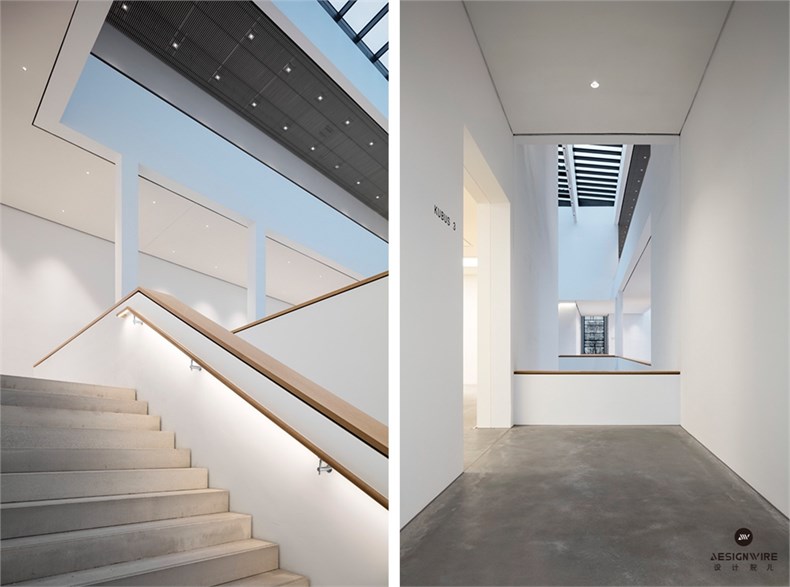
▲连廊 terrace
整个金属织网覆面由72组独立的镀铜不锈钢面板构成,总面积4635平方米。织网表皮悬挂于固定在封闭幕墙外直径25毫米的钢管。 在夜晚,自重44吨,高21米的立面可以通过103组聚光灯照亮,the mesh consists of a total of 72 individual bronze-colored stainless steel panels, together spanning an area of 4,635 square meters. During the hours of darkness, this special, 21 meter high external envelope, which weighs 44 tonnes, can be illuminated with 103 spotlights.
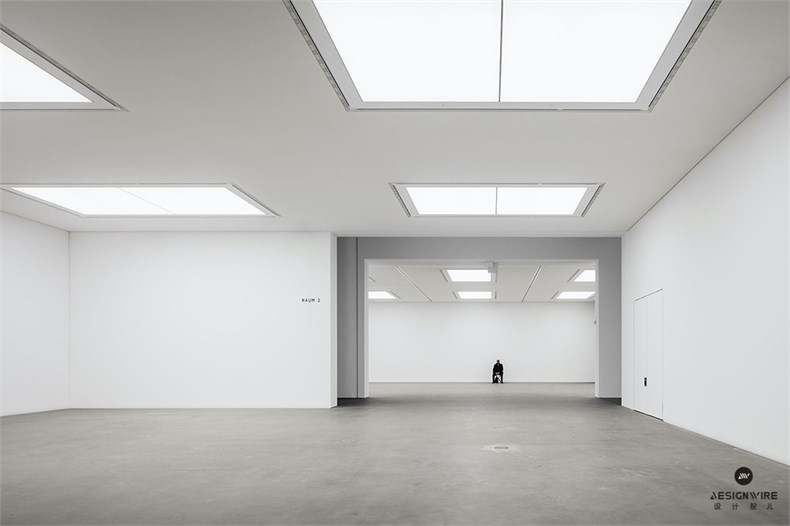
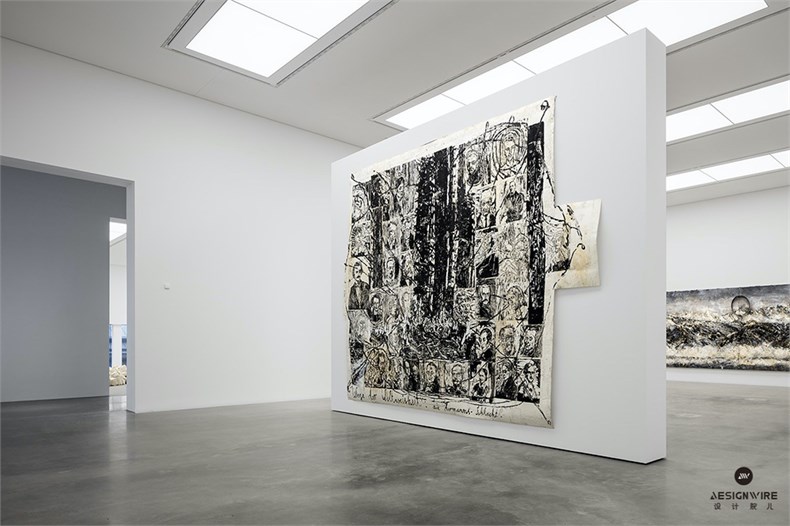
▲展厅 exhibition hall
“城中之城”的概念通过一座中央光庭得以实现,中庭相当于博物馆内的“市民广场”,是城市公共空间的延展, 也是美术馆展览空间的开端。从这里可以直接到达纪念品商店。安塞姆·基弗的一幅浮雕作品处于视线的焦点处,其与另外若干艺术作品刻画出中庭的形象。 参观者将通过中央光庭内的参观路线到达新建建筑上层的展览空间。美术馆开幕后,与旧赫尔曼·彼凌建筑的连接处将作为一座灯光装置展厅由当代艺术家詹姆斯· 特瑞尔进行重新设计,这里的雕塑花园将以崭新的空间背景呈现原先展示于此的一系列著名雕塑作品,例如Ni-gel Hall的《慢动作》和Christoph Freimanns的《巨虫2》。 建筑空间布局令美术馆和城市空间在功能和视线上产生多元联系,艺术感知通过建筑形式被引入城市空间,同时城市的日常生活也在建筑内部获得了映射和呈现。
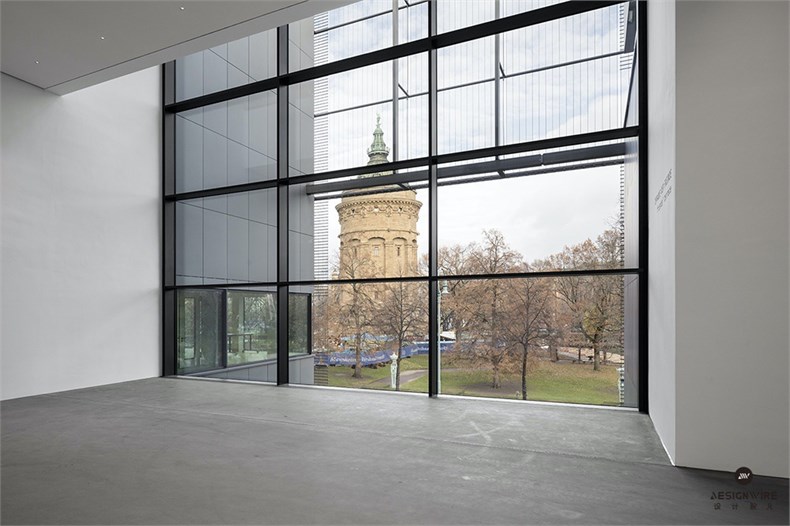
▲艺术馆的窗景 window view
In keeping with the „city in the city“ concept, the atrium of the museum was developed as a „market place“ which is accessible to all citizens as an extension of public space and, at the same time, forms the entrée to the Kunsthalle. From here, there is di- rect access to the restaurant and museum shop. However, on entering the eye is caught by Anselm Kiefer’s lead relief which, together with some of the museum’s other works of art, defines the atrium.Visitors to the museum are guided through the atrium to the exhibition areas in the upper stories of the new building. Fol- lowing the opening of the museum, the Billing building will be accessible via the Athene tract, which has been redesigned by James Turrell as a light space. From there, visitors can move on to the sculpture garden, which is presented in a new cloak but dis- plays well-known works of art that were already on display prior to the modernization, such as Nigel Hall’s „Slow Motion“ and Christoph Freimann’s „Großer Bug 2.“This space concept results in the museum and city spaces being functionally and visually interwoven, ensuring that the art radi- ates out into the city through the architecture and also that the city flows virtually without barriers into the rooms of the new buildings.
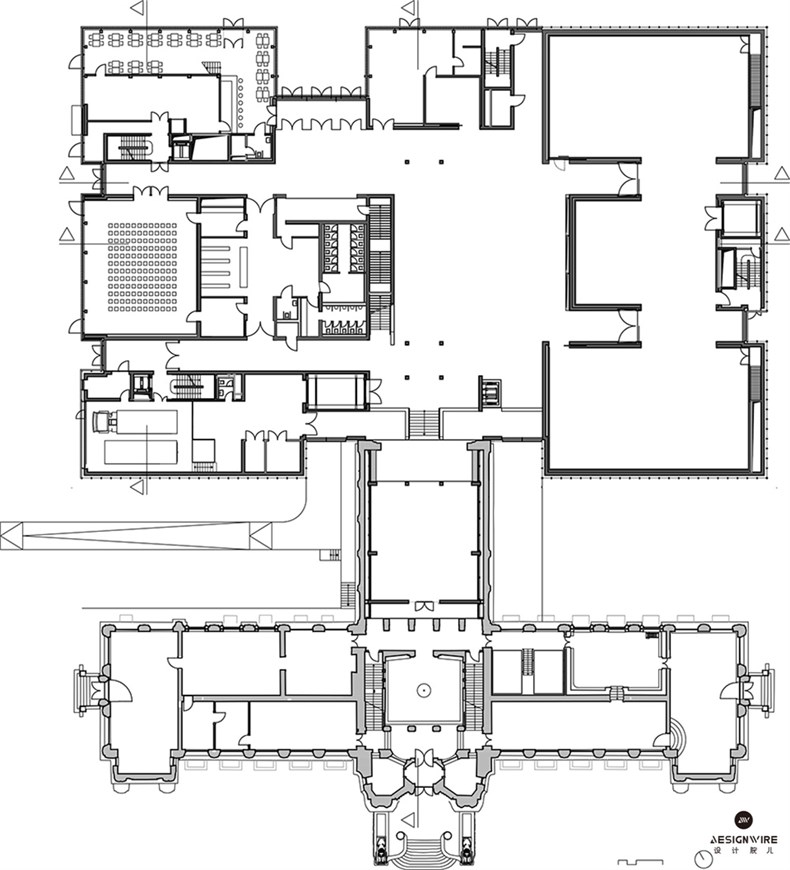

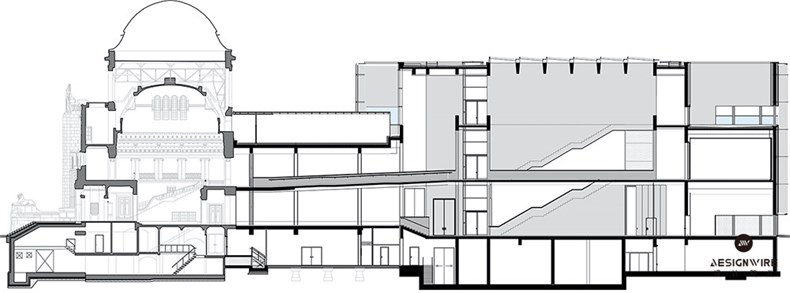

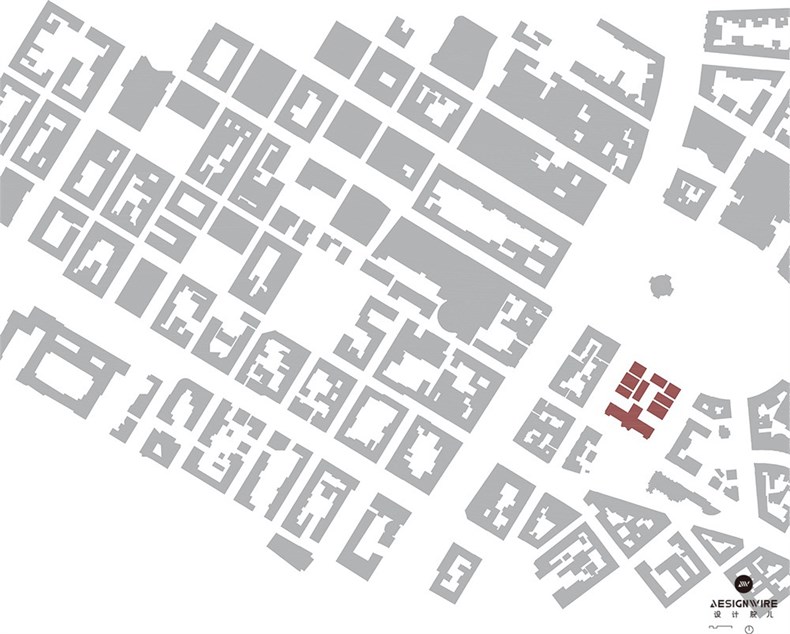



设计单位: Meinhard von Gerkan and Nikolaus Goetze with Volkmar Sievers
竞标项目管理: Di Miao-Weichtmann
竞标设计团队: Ulrich Rösler, Mira Schmidt, Steffen Lepiorz, Liselotte Knall, Kai Siebke, Frederik Heisel
3D设计团队: Markus Carlsen, Tom Schülke, Jens Schuster, Christoph Pyka, Kenneth Wong, Björn Bahnsen
项目执行管理: Liselotte Knall, Kerstin Steinfatt
细节设计团队: Ulrich Rösler, Raimund Kinski, Amra Sternberg, Viktoria Wagner, Hanna Diers, Michèle Watenphul, Anna Falkenbach, Felix Partzsch
场地监管(6到9期): W+P Gesellschaft für Projektabwicklung Sven Lemke, Kevin Puhmann
客户: Kunsthalle Mannheim Foundation
净面积: 17,366 m²
Edit by Designwire
